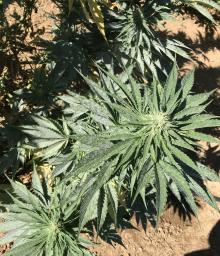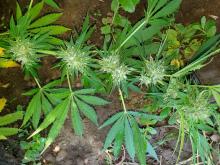See:
Hop (Humulus lupulus) - Powdery Mildew
By C. M. Ocamb
Cause Powdery mildew on hemp, caused by the fungus, Golovinomyces spp., has been reported in Kentucky, Ohio, and New York. During 2018 and 2019, greenhouse growers of hemp plants in western Oregon reported powdery mildew on leaves and buds of several hemp cultivars and the powdery mildew fungus was identified as Golovinomyces ambrosiae (synonym G. spadiceus). OSU observed the natural infection of field-grown hemp by G. ambrosiae in 2021. In addition to infecting cannabis, Golovinomyces sp., can also infect members of the Asteraceae family and has been reported on sunflower, dahlia, daisy, Jerusalem artichoke, zinnia, and ragweed.
Podosphaera macularis has been reported pathogenic on hemp following artificial inoculation and it has also been reported on cannabis in Switzerland and Canada. During 2020, OSU confirmed natural infection of field-grown hemp by P. macularis in Oregon.
Golovinomyces spp. can produce sexual spores in ascocarps known as chasmothecia but evidence of ascospores in association with cannabis is lacking for the Pacific Northwest. Podosphaera macularis is not reported to produce chasmothecia in Oregon as only one of the two requisite mating types needed for sexual recombination is currently present in the region. Podosphaera macularis is known to overwinter as mycelium on infected crown buds of hop in the field.
Symptoms Disease may occur at all stages of growth, affecting leaves and buds, even immature first true leaves of susceptible varieties will develop disease after inoculation based on preliminary studies conducted by OSU. Infections on susceptible leaves appear as whitish, powdery spots on the upper leaf surface. Entire leaf surfaces can be covered with powdery mildew and leaf petioles can also be infected as well as flower bracts. As foliar infections of Golovinomyces spp. age, if chasmothecia were to be produced, they would become visible as the small, nearly spherical fruiting bodies turn from yellow to dark-brown-black within the patches of powdery mildew.
Cultural control
- Do not overlap hemp cropping cycles because powdery mildew can reach epidemic levels when young plants are in the vicinity of older plants that have powdery mildew.
- Removal of infected leaves early in disease development can aid in delaying epidemics.
- Applications of silicon at 660 to 1322 lb/A to hemp roots can significantly decrease the severity of powdery mildew in the upper and mid-canopy portions of plants in soilless systems.
- Maintain adequate nitrogen levels but do not over-apply because more succulent tissue is more susceptible.
Chemical control Thorough spray coverage is essential to protect leaves. Apply protective fungicides before disease is active and reproducing. Chemical and cultural controls can help to keep disease levels low, both in terms of disease incidence and severity before plants begin flowering.
- Bicarbonates help to control powdery mildew. Thorough coverage is essential.
- Bi-Carb Old Fashioned Fungicide at 4 teaspoons/2 gal water on 7- to 10-day intervals. May be applied up to the day before harvest. H O
- Carb-O-Nator at 2.5 to 5 lb/100 gal of water on 5- to 14-day intervals, depending on disease pressure. A field study by the University of Tennessee showed efficacy when applied at 5 lb/A on 10-day intervals. Preharvest interval is zero (0) days for all listed crops. 4-hr reentry. O
- Kaligreen at 2.5 to 3 lb/A on 7- to 10-day intervals. May be applied up to the day before harvest. 4-hr reentry. O
- MilStop SP at 2 to 5 lb/A on 7- to 14-day intervals. Can be applied up to and including the day of harvest. 1-hr reentry. H O
- Vacres at 2.5 to 5 lb/A on 7- to 14-day intervals. Preharvest interval is zero (0) days. 4-hr reentry.
- Oils help to control powdery mildew. Thorough coverage is essential. Do not spray if temperature is below 50°F or above 90°F or when plants are wet or under heat or moisture stress. See label for details. Do not use when foliage is wet as good coverage is essential.
- Bonide Bon-Neem II.
- Conc Worryfree Vegol Yearround Pesticidal Oil. H
- Mildew Cure. O
- Monterey Horticultural Oil. O
- Omni Supreme Spray.
- Trilogy at 0.5% to 1%. Not labeled for use in Oregon. 4-hr reentry. O
- Regalia (Group P5) at 1 to 4 quarts/A on 7- to 10-day intervals. Does not benefit from the addition of an adjuvant. Studies in Tennessee show efficacy on powdery mildew. Preharvest interval is 0 days. 4-hr reentry. O
- Sil-Matrix LC as a 0.25 to 1% spray solution on 7-day or longer intervals. Is also labeled for control of spider mites and aphids. Studies by the University of Tennessee did not show this product to be significantly better than nontreated plants. Preharvest interval is 0 days. 4-hr reentry. O
- Sulfur formulations (Group M2) are registered for powdery mildew (Safer Brand Garden Fungicide /Flowers Fruit & Veg. Conc, etc.). Sulfur is fungitoxic in its vapor phase and, therefore, is effective only when air temperatures promote volatilization. Sulfur volatilizes above 65°F but becomes phytotoxic above 95°F. Using it above 85°F is not recommended. Although sulfur reduces sporulation of established infections, it is primarily a protectant and must be applied before infection. A greenhouse study by the University of Tennessee showed good efficacy with sulfur applied on 7-day intervals. See label for details on rates and reentry intervals.
Biological control Efficacy unknown in the Pacific Northwest.
- Actinovate AG. 1-hr reentry. O
- Actinovate Lawn & Garden at 1/2 to 1 teaspoon/gal water. H O
- Double Nickel LC at 1 to 6 quarts/A on 3- to 10-day intervals. Can be applied the day of harvest. 4-hr reentry. O
- Fungisei. Studies from TN showed no reduction in powdery mildew levels at 30 fl oz/A compared to non-treated plants. 4-hr reentry. O
- LifeGard WG at 1 to 4.5 oz/A on 3- to 14-day intervals for activating plant resistance. Refer to label for appropriate rate per application volume. Studies by the University of Tennessee did not show this product to be significantly better than nontreated plants. Preharvest interval is 0 days. 4-hr reentry. O
- Serenade Opti. Can rotate with other fungicides. 4-hr reentry. O
References Akinrinlola, R.J., and Hansen, Z. 2021. Assessment of fungicide products for control of hemp leaf spot and powdery mildew in Tennessee, 2020. Plant Disease Management Reports: Report No. 15:V082.
Akinrinlola, R.J., and Hansen, Z. 2022. Assessment of fungicide products for control of hemp leaf spot and powdery mildew in Tennessee, 2021. Plant Disease Management Reports: Report No. 16:V048.
Bates, T., Wiseman, M.S., Garfinkel, A.R., Gent, D.H., and Ocamb, C.M. 2021. First report of powdery mildew caused by Podosphaera macularis on hemp in Oregon. Plant Health Progress 22: https://doi.org/10.1094/PHP-04-21-0071-BR.
Dixon, E., Leonberger, K., Amsden, B., Szarka, D., Munir, M., Payee, W., Datnoff, L., Tubana, B., and Gauthier, N. 2022. Suppression of hemp powdery mildew using root-applied silicon. Plant Health Progress 23: https://doi.org/10.1094/PHP-01-22-0005-SC.
McPartland, J.M., Clarke, R.C., and Watson, D.P. 1999. Hemp Diseases and Pests: Management and Biological Control. CABI Publishing, New York, New York.
Rivedal, H.M., Wiseman, M.S., Richardson, B.J., Massie, S.T., Garfinkel, A.R., Ocamb, C.M., and Gent, D.H. 2023. Characterization of powdery mildew fungi affecting hemp in the Pacific Northwest. PhytoFrontiers 3:https://doi.org/10.1094/PHYTOFR-07-23-0099-R.
Wiseman, M.S., Bates, T., Garfinkel, A.R., Ocamb, C.M., and Gent, D.H. 2020. First report of powdery mildew caused by Golovinomyces ambrosiae on hemp (Cannabis sativa) in Oregon. Plant Disease: in press.




